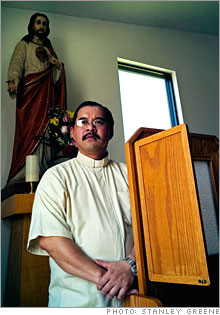New Orleans: An immigrant community thrivesThis 20,000-strong Vietnamese enclave is ferociously self-sufficient.NEW ORLEANS (Fortune) -- In New Orleans, not everybody waits on the all-clear from the government. A shining example is the 20,000-strong Vietnamese community, centered around Mary Queen of Vietnam Church in the far eastern reaches of New Orleans. The group is ferociously self-sufficient and was among the first to return to New Orleans after Hurricane Katrina in 2005.
Its low-lying neighborhood suffered massive flooding, yet hundreds came back to their homes before the officially sanctioned "look and leave" date, Oct. 5, 2005. The pastor for the community, Vien The Nguyen, returned to celebrate mass on Oct. 9, five weeks after Katrina struck. Bad as the storm was, Nguyen's community has seen worse. "The first people to return were the older people," said the priest, who everybody calls Father Vien. "People said, 'There's no AC or running water.' And they said, 'OK, so what's the problem?' They have been through so much worse than this. My own family didn't have electricity until 1973." Nguyen was a 12-year-old refugee at Fort Chafee, Ark., in 1975, when the archbishop of New Orleans invited the camp's refugees, mostly Catholics, to town. Many were fishermen, though the current generation has almost completely abandoned the trade. Shortly after coming back to New Orleans, Nguyen convinced Entergy, the local utility, to divert electric power from the central business district because so many of his people had returned. Today, he skirmishes with FEMA, which has overstayed its welcome on a 20-acre parcel of land across the street from the church, where Mary Queen of Vietnam plans to build a retirement home. Hundreds of FEMA trailers remain on land the church has let the government use free of charge, even though FEMA denied church members first dibs on spots in the trailer park. "They were flippant," said Nguyen, whose bright smile contrasts with a mustache that droops to his lower lip. "They told me that to favor my people was racist and against the law." More recently, Nguyen has led a successful fight against a city landfill a mile from his church, which he fears is a repository of toxic waste. "Before, we asked the government to stay out of our way," he said. "What we needed to do we did ourselves. Now we've become more active in the political life of the city only because we saw the city government as impeding our way of life." As I leave his church, I ask Father Vien to recommend somewhere I can get a bowl of noodles before heading back to central New Orleans. He sends me a few blocks away, to Ba Mien, a cavernous and bustling restaurant in an only partly renovated strip mall. I slurp noodles (for $6.25) and watch a Vietnamese-language talent show on cable television, which I assume is piped in from Vietnam but in fact is being broadcast from Houston. New Orleans is known for its cuisine and entertainment, but this certainly isn't what people have in mind. Where's the relief money? Billions have been spent to rebuild New Orleans. But not enough is reaching the local economy. Here's why. The next energy crisis: More than a quarter of America's oil flows through southern Louisiana. Too bad the land is slowly sinking into the Sea. Video: Photojournalist Stanley Greene and Fortune senior writer Adam Lashinsky document the progress in New Orleans. |
Sponsors
|

